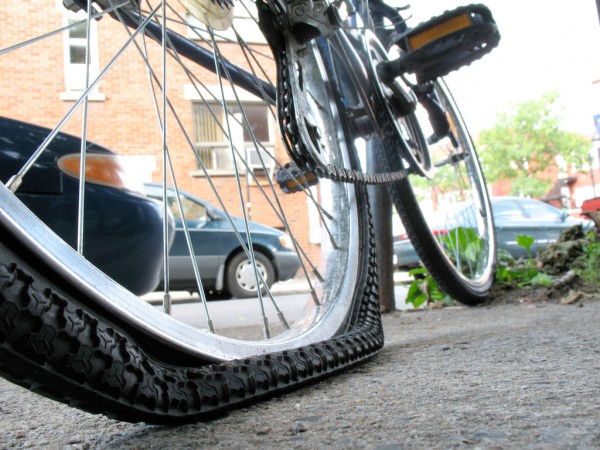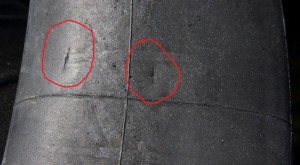 If you have been cycling for a reasonable amount of time then the odds are fairly good that you have encountered a flat tire or two in your time. In many cases you can usually repair the tire with a decent puncture repair kit, but that doesn’t mean that they aren’t still an annoyance that most cyclists would be more than happy to do without.
If you have been cycling for a reasonable amount of time then the odds are fairly good that you have encountered a flat tire or two in your time. In many cases you can usually repair the tire with a decent puncture repair kit, but that doesn’t mean that they aren’t still an annoyance that most cyclists would be more than happy to do without.
While some flat tires are unavoidable, there are measures that you can take to ensure that there is less chance of one occurring when you are out on a ride. Here we look at a few ways to prevent a flat tire from ruining your ride.
Proper Tire Pressure
First and foremost, the proper tire pressure is the key to making sure you do not get a flat. Over inflating is just as big of a problem as under inflating.
Over Inflation – Many people are guilty of pumping their tires too much thinking that hard tires are going to make them faster. What can end up happening is as the day heats up it will make the air in the tires expand and literally burst.
Under Inflation – Pinch flats are one of the leading causes of flat tires. If you get something that looks like a snake bite in your tube it was likely caused by a pinch flat. This occurs because the rim hits the tire and pinches the tube in between.
Pro Tip: Pump your tires to the ideal psi before each and every ride.
Talcum Powder
While many flat tires are caused by something on the road, general wear and tear on the tire itself can also become an issue over time. In particular, friction between the inner tube and the tire can lead to a hole being created that will cause the tire to deflate over time.
To prevent this, you should aim to make the rubber of the inner tube a little slippery so that the effects of that friction are reduced. Whenever you get a new inner tube, be sure to dust it with a healthy coating of talcum powder so that you can reduce the effects of friction and mitigate the issue.
Careful Riding
In many cases your tire won’t immediately puncture when it has picked up a piece of debris on the road. Sometimes, said debris simply gets caught in the tire and keeps rotating with it until the weight placed upon it leads it to penetrating and causing a flat tire.
This means that, with a little careful riding, you can prevent the sorts of punctures that sneak up on your like this. If you have just cycled through an area that had a less than optimal surface, be sure to take a little bit of time to check your wheels. Simply hop off the bike and slowly rotate each one of your wheels. If you notice any debris there get rid of it and check the area to make sure that it hasn’t punctured the tire. If you’re lucky there will be no problem, but if there is a puncture you will have at least caught it early enough for you to repair it without any issues.
Tire Wipers
Tire wipers are becoming increasingly rare in the modern cycling environment, but if you look hard enough you should still be able to find them around.
These nifty little devices will connect to your brakes or fenders and will work to get rid of any debris that has attached itself to the tire while you ride. It does this through the use of a rubber coated metal bar, which brushes against the tire as it rotates and knocks off any debris. This should mean that the debris doesn’t have the chance to penetrate into the tire during the next wheel rotation, reducing the risk of a puncture.
Choose Your Route Carefully
If you are simply cycling for the sake of fitness and aren’t interested in mountain biking or going off-road, a little bit of route planning will ensure that you avoid areas that present a potential danger to your tires, thus allowing you to avoid causing issues.
In most cases riding on tarmac or asphalt is much safer for your tires than going off road, so try to stick to good surfaces as much as possible. Of course, this doesn’t mean you can get careless, so always have your eyes open when you are riding so that you can avoid any hazards.
 A flat tire is something that practically every cyclist has to deal with at some point or another, but many novices may be unaware that there are actually a number of different ways that you can get a puncture, each of which requires a slightly different method to deal with or prevent.
A flat tire is something that practically every cyclist has to deal with at some point or another, but many novices may be unaware that there are actually a number of different ways that you can get a puncture, each of which requires a slightly different method to deal with or prevent. A pinch flat most commonly occurs when you run over something with your bike that causes the inner tube to punch against the wheel rim, resulting in a flat tire. In the worst case scenarios they will require you to replace the inner tube and, in some cases, may even lead to dents forming in the rim itself. However, in many cases, you should find that the tire itself is unaffected.
A pinch flat most commonly occurs when you run over something with your bike that causes the inner tube to punch against the wheel rim, resulting in a flat tire. In the worst case scenarios they will require you to replace the inner tube and, in some cases, may even lead to dents forming in the rim itself. However, in many cases, you should find that the tire itself is unaffected.